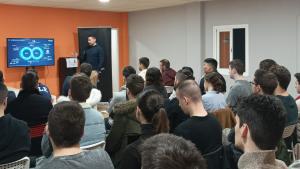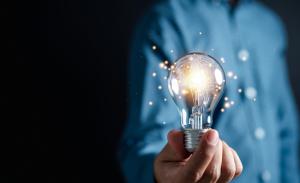Green Manufacturing: How AI is Driving Sustainable Practices - Asset Display Page

Green Manufacturing: How AI is Driving Sustainable Practices

Green Manufacturing: How AI is Driving Sustainable Practices
května 15, 2024
How can companies achieve the twin goals of making the world a better, more sustainable place while remaining financially competitive? And how can companies make sure they are using the right tools to achieve these lofty, important goals?
These are the puzzling conundrums that governments, business leaders, scientists and many others across the globe have been trying to solve for decades. In recent years, the best answers to these important questions have become clearer.
As always, technology finds a way, pointing to the deep connection between Artificial Intelligence and sustainability. AI is transforming the world into a more sustainable place, demonstrating its enormous impact on the manufacturing industry.
AI and Sustainability in Manufacturing: This brave new world is not without challenges that every manufacturer needs to understand in order to navigate the way ahead. Among these is that AI requires clean, highly specific data, meaning heightened attention must be paid to how AI tools are used in data collection.
Manufacturers need to identify proper use cases before generating, selecting and storing data. This will mean investments towards sensors, connectivity and cloud solutions, for example. The key is to recognize those use cases with the biggest financial and business impacts to fully assimilate what AI can do for your manufacturing plants and your industry overall. Importantly, to ensure they do this right, businesses need to find a partner with AI experience who can guide them through every step of the process.
There are many important reasons for companies to use AI effectively. Artificial Intelligence in manufacturing can help manufacturers reduce waste and energy use and promote better consumption of earth’s precious natural resources. These sophisticated learning machines working in combination with intelligent networks can help control industrial pollutants and vastly improve waste management.
Proper coordination between equipment and systems is crucial for detecting leaks, potential hazards, and deviations from industry standards. This coordination not only ensures compliance with government regulations, such as those set by the United States Environmental Protection Agency and other relevant jurisdictions, but also facilitates efficient operations.
An illustrative example of this coordination is the utilization of Internet of Things (IoT) technology, which connects various devices across networks. IoT has found applications in diverse industrial settings, from refrigeration units and thermostats to retail establishments. However, given the wide array of available technology and tools, companies must select the appropriate systems that align with their manufacturing processes and adhere to local regulations.
Energy Efficiency and Resource Management: Artificial intelligence can be efficiently used to reduce the consumption of natural resources and energy demands associated with human activities. When it comes to energy research, the main focus areas include neural networks, expert systems, pattern recognition, and fuzzy logic models, along with energy production and distribution, operations and maintenance.
In one of our environmentally sensitive reverse logistics success stories, NEORIS worked with a Silicon Valley Telecommunications & Manufacturing company with 74,000 employees and a $498 billion valuation. They expanded rapidly during the pandemic and needed to reevaluate their Global Services Logistics & Operations – Reverse Logistics Asset Recovery. We worked with them to provide an Agile and DevOps Digital Solution, reducing time cycles to save them over $600K per year. In addition, this Green Initiative improved their efficiency and product reuse process, reducing transaction costs around 30%, while simultaneously allowing them to achieve their sustainability goals and reduce their environmental footprint.
Air Pollution Management: Artificial Intelligence can play a key role in a company’s practical strategy to manage and reduce air pollution from the manufacturing process. For example, AI may gather data from sensors and satellites and assist scientists in creating climate models. The right partner with deep experience in AI who also understands your industry is key to creating the most beneficial setup to ensure the practicality and effectiveness of the applied techniques.
Here are just a few examples of how AI can help improve air quality for manufacturers in a broad range of sectors, locations and scenarios:
- Pollution Level Warnings: Urban residents may be warned about the pollution levels in their neighborhoods using simulations driven by AI, improving overall health and safety in cities across the globe.
- Pinpoint Pollution Sources: There are tools available that can quickly and accurately pinpoint the sources of pollution, vastly improving health for those potentially impacted.
- Sensors & Cameras: Using information from cameras, radar sensors, moving objects and other devices, AI can minimize air pollution, bringing rapid 360-degree awareness of issues before any negative impact.
- High Performance Air Purifiers: AI-enhanced air purifiers may continually record environmental and air quality data and modify their filtering performance, always ensuring healthy levels no matter the conditions.
One of our biggest success stories applying AI to create sustainable pollution reduction solutions was for a company under a tight timetable to completely revamp its 25-year-old patchwork process of outdated technologies and legacy software used to run its industrial ovens. The company needed to comply with strict EPA standards, while maintaining 24/7 operations. With hundreds of sensors, AI, testing and other methods, NEORIS worked in close collaboration with the company’s engineers. In a rapid three-month turnaround, we established a completely new process, resulting in reduced costs, lowered emissions and easier to use, error free, labor-saving operations.
Health and Safety: According to Statista, the market size in the Computer Vision market is projected to reach US$25.80 billion in 2024. What’s more, with its annual growth rate of 10.5%, it should nearly double in the next few years, resulting in a market volume of US$46.96 billion by 2030.
One of our most important Computer Vision success stories came through our close work with Cemex, a leading global construction materials company which needed to improve logistics to more rapidly fill orders, reduce costs, and make its processes more environmentally sound. We used a combination of AI and Computer Vision for enhanced process management in their fulfillment centers to reduce truck wait times. This eliminated unnecessary exhaust and allowed customers to receive shipments faster, all while simultaneously improving employee safety.
Data Insights: The use of AI for pollution reduction in the manufacturing sector stands out for its robust growth and impact which will only accelerate in the years ahead. According to PwC UK research, deploying AI for environmental applications may contribute up to $5.2 trillion to the global economy in 2030.
Simultaneously, the use of AI technology could potentially reduce Global Greenhouse Gas (GHG) emissions by 4% by 2030. As part of this significant environmental change, AI may also create a net increase of 38.2 million jobs across the global economy, particularly in higher-skilled roles.
Companies who wield AI correctly and efficiently will be able to achieve their Environmental and Sustainability Goals (ESG). This will help them stay ahead of their competition while ensuring their employees, customers and clients know they strongly value the environment and the communities they operate in.
Sustainability In Business and Technology as the Enabler: In the end, sustainable solutions are about companies thinking beyond mere profit to the impact they have on their communities. All organizations need to meet their sustainability commitments, demonstrating they are responsible to all their stakeholders.
Importantly, these green manufacturing commitments are also what makes profit itself sustainable in the long term. Ensuring a company can have a positive impact on the communities they work in generates tangible value for organizations. Sustainability goals go hand-in-hand with generating this value for organizations, simply by making a positive impact. When companies take the time to put sustainable practices in place, they create added value for customers who increasingly seek out products and services that put commitment to the future of the planet beyond words into real action.
Ultimately, being responsible to the planet through technology is the right thing to do. Technology such as AI is the enabler, the tool that when wielded correctly creates this added value, allowing companies to efficiently and cost-effectively incorporate sustainable solutions into their manufacturing processes. With stakeholders from employees to clients and customers seeking out companies with this environmental mindset, sustainability for the planet is what creates sustainability for your business.
The Promise of AI and A Better World for All: Through the promise of AI, manufacturers can make the world a more sustainable place, allowing their clients, customers and other important stakeholders to reap the benefits.
Find out more about NEORIS and how we can help you use Generative Artificial Intelligence to achieve your sustainability goals and set your company apart from the competition.
Click on the link for more examples of how we’ve helped companies use AI in cost effective, innovative ways to help improve their efficiency and make the world a better place for all of us.
Featured
-
NEORIS obtiene la certificación del Esquema Nacional de Seguridad (ENS) en España
ledna 14, 2025
-
Revolucionando las operaciones: cómo la visión por computadora está transformando las industrias de manufactura y logística
prosince 17, 2024
-
Las empresas no siempre sacan todo el provecho a sus redes
listopadu 29, 2024
-
NEORIS gana el bronce en los Premios W!N 2024 por We Are NEOS
listopadu 19, 2024
Most viewed
-
IA, SIM Swap y disrupción: las tendencias más destacadas del MWC 2024
března 25, 2024
-
NEORIS lanza HealthCheck para ayudar a las empresas frente al Coronavirus
března 27, 2020
-
NEORIS se convierte en Socio del Año de Microsoft
července 23, 2020
-
Microsoft reconoce a NEORIS como socio del año para SAP en AZURE
července 23, 2020











